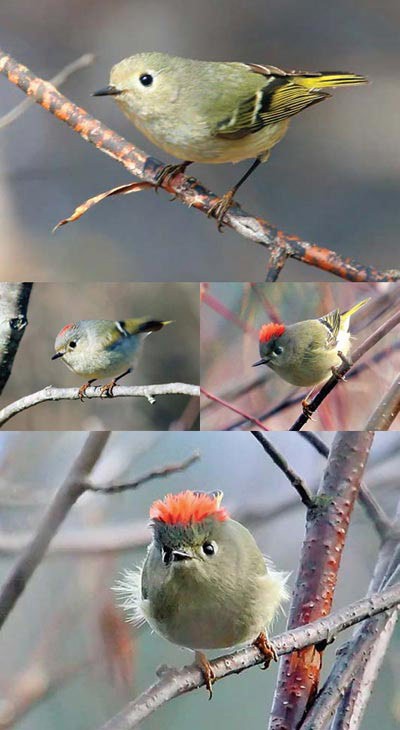Most of the time, a male ruby-crowned kinglet is a fraud with feathers. When he appears, neither ruby nor kingly, you may wonder how he got his name. Pale green and gray, small and fleeting, he is among the plainest birds in the woods. You may even turn your binoculars instead toward the warbler or woodpecker. But resist the urge to complain or pass him by. Keep watching the kinglet. The reward will be an explosion of feathers that will make your heart pound and your knees wobble.
From mid-April to early-May, no one in the Northeast is far from a ruby-crowned kinglet. Males are rushing north to claim territories in mature coniferous woods. Along the way, they stop to feed and rest in most any woodland or thicket, even your own backyard. That’s when they offer us essential lessons on how to enjoy birds during spring migration.
First, be stealthy. Bright colors and white Tshirts are fashion violations in a birdwatcher’s wardrobe. Be alert yet relaxed, with smooth, easy movement. Nothing spooks a kinglet or other forest bird more effectively than sudden motion; even raising your binoculars from chest to eyes can send a nearby songbird off into the woods. So slow down in every way, which is good advice for doing most anything in the woods. If you rush, the kinglet cannot teach you your lesson in humility.
His first clue is audible. Most songbirds sing during migration. I hear about 80 percent of a woodland’s spring birds long before I see them. And in the dawn symphony, the kinglet, this rather plain bird, would make Sinatra blush. Here is what he sings (read it aloud and accelerate as you go): “tee-tee-tee-tee, tew-tew-tew-tu-tu-tu-tu, teedle-dee! teedle-dee! teedle-dee!” That long, rich blast of notes makes me swoon (despite, best as I can tell, my lack of female kinglet genes). But the show only gets better from there.
Most of the time, the male’s ruby crown is inconspicuous or little more than a crimson wisp. But when he sings in the presence of a female, he begins to show his mettle – those feathers become, well, erect. It is intended to be a turn-on for females. But when another male enters the scene, the courtship drama shifts to fireworks.
In the company of a competing male, the ruby-crowned kinglet unleashes shock and awe. He leans forward, cocks his tail high, sings with vigor, and sends a bolt of energy to his crown. It explodes in a ruby flash, as if flames were erupting from his head. Facing his rival, he jerks from side to side in the songbird equivalent of bucks locking horns. Biologists call it “agonistic behavior.” I call it one of birdwatching’s finest moments.
Birds in spring offer us an abundance of these moments. Few birders actually see full-blown kinglet flares, which isn’t necessarily a bad thing. We can spend a lifetime in the woods with birds and still not learn half their secrets. Consider that an invitation to dwell in the kinglet’s court this spring.


